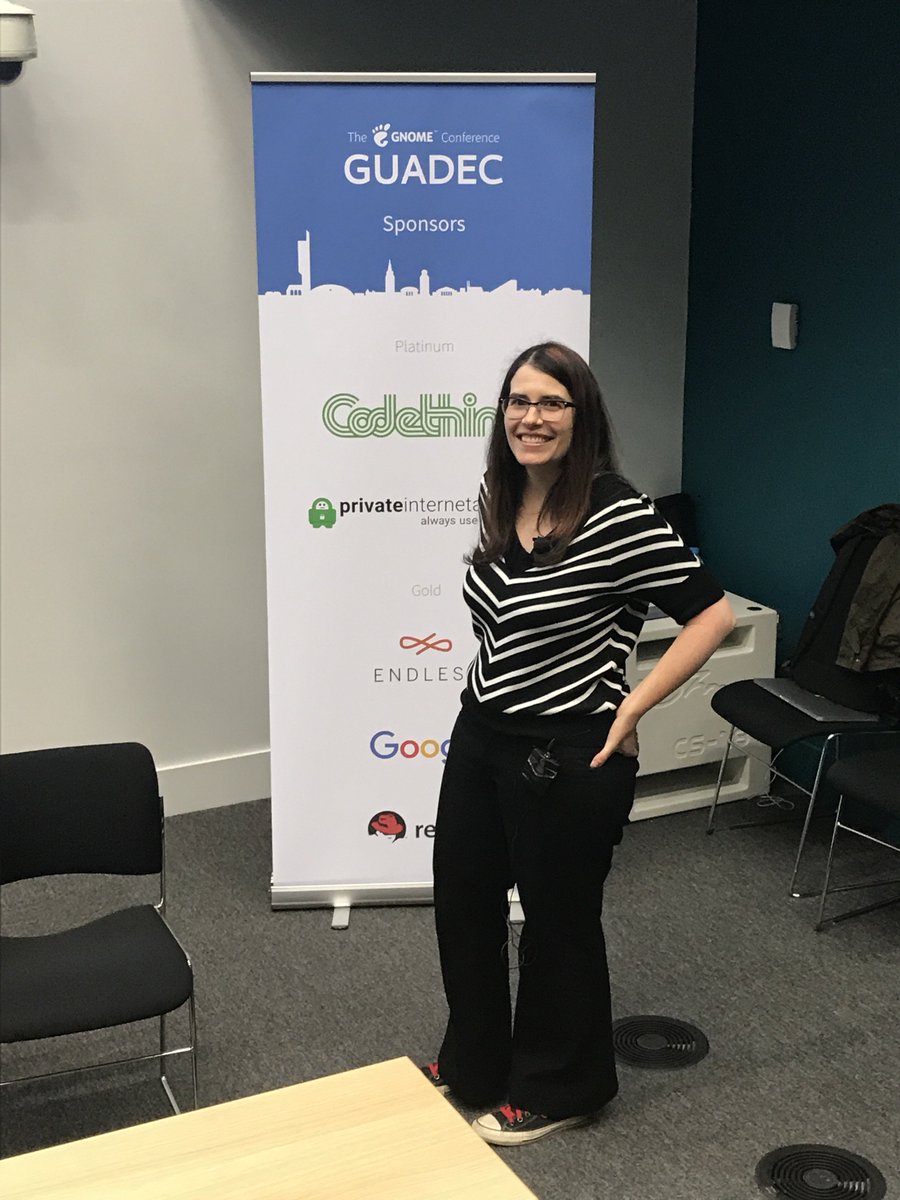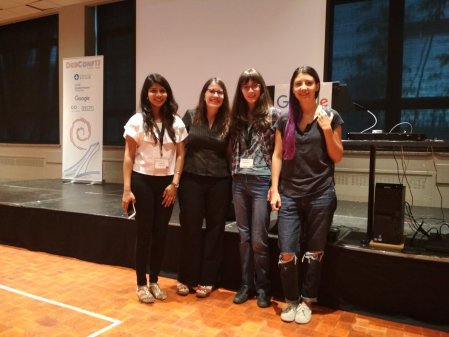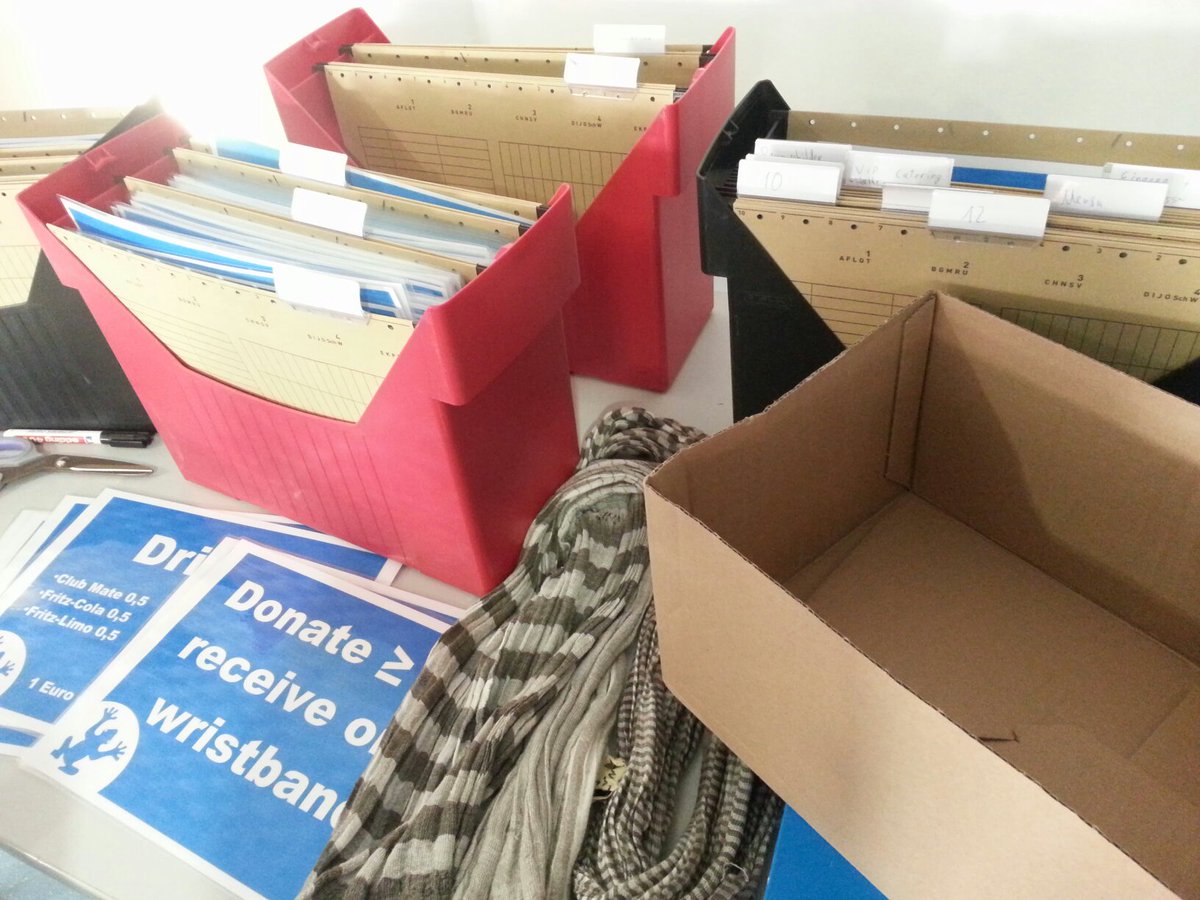![[RSS]](/static/img/feed-icon-14x14.2168a573d0d4.png) Conservancy Blog
Conservancy Blog
Displaying posts
tagged conservancy
![]()
Late Summer Conference Report
by on September 29, 2017
I’ve been traveling quite a lot recently and have had the good fortune of participating in some dynamite conferences. Often we’re so busy with our work and travel that we aren’t able to make the time to report on it properly, which results in a lot of our acomplishments and activities happening silently1. August’s travel was intense, and while my inbox backlog continues to be a bit unnerving, I’ve got to tell you about where I’ve been before September is completely over too!
GUADEC: GNOME’s 20th Birthday!
As many readers probably know, I’m an enthusiastic user and fan of GNOME. And, as the former Executive Director of the GNOME Foundation, I was so thrilled when I was invited to give a keynote speech at the annual main GNOME conference, GUADEC. Given that this year is GNOME’s 20th birthday, it was a special year to be able to participate in the conference.
GUADEC was invigorating. With Ubuntu returning to GNOME and the success of Endless and other commercial initiatives around GNOME, the GNOME community is optimistic and focused on the future. There were many new contributors but also a great showing amongst folks who have been around the community for a long time.

My talk focused on the personal ethical responsibilities of free software contributors and how GNOME contributors can engage in the process of steering our technology in the direction of transparency and security. While I wasn’t intending to talk about medical devices very much in my talk, for a majority of the audience this was their first GUADEC or free software conference and the topic came up to illustrate some of my main points. As a society we’re building our critical infrastructure on proprietary software, entrusting single companies with some of our most important information and interactions. I strongly believe that we need technologists to stand up for ethical technology now, especially within the companies that are producing it. I recommended that contributors engage with management to discuss the long term business advantages of doing the right thing. As it turned out, there were also several young attendees in the audience who have implanted medical devices so it was a great opportunity to connect. Over time, these issues will impact more and more people.
I was excited to see Neil McGovern, the GNOME Foundation’s new Executive Director, in action. After I moved to Conservancy, I served on a Hiring Committee to help the Foundation find the right person for this role. There were many very impressive candidates, but Neil was the stand out. Neil gave an inspiring freedom-focused talk, revealing the great job he’s already doing.
There was also a big party for GNOME’s 20th birthday which was a lot of fun. I moderated a panel on the history of GNOME, and learned a lot of fun tidbits about GNOME’s past! I was also excited to see the “Pants Award” go to Bastian Ilso, who puts together awesome videos for GNOME releases (and ropes me into doing the voiceovers too).
DebConf
Soon after I got back from GUADEC it was time to head to DebConf. I could only make it for part of DebConf, which definitely left me wishing I could have been there for the whole time.

This time the conference was in Montreal, and I had the privilege of giving a presentation about Outreachy. The talk was very well attended and I left plenty of time for questions. The best part was getting to meet a number of Outreachy alums, mentors and coordinators.
I also had the opportunity to talk to Debian folks about the copyright aggregation project and to participate as a Debian Developer. This was my first Debian event since I became an official non-uploading Debian Developer. While I felt more of a responsibility to work proactively on things that Debian needed to have done, I also felt a strong sense of belonging in the community. When DebConf was held in New York seven years ago, I went briefly for a screening of Patent Absurdity, which I was interviewed in, but was so intimidated by the conference that I basically ran away immediately after! (Somewhat relatedly, I recently recorded a brief video about Imposter Syndrome.) Being recognized as an official contributor to the project helps not only to feel like your contributions are appreciated (even if they aren’t code) but also that you are more than welcome in a community - that you are a part of it.
FrOSCon
The last conference I got to this summer was FrOSCon. I hadn’t heard of this conference until recently and was surprised to learn how big it is. Primarily a local German conference, FrOSCon attracts almost 2000 people. Like FOSDEM, the event runs only over the weekend. Also like FOSDEM, the conference organization is extremely impressive. When I arrived the night before the conference, I went over to see if I could help get things set up but there were so many people there to help they actually had nothing for another person to do!
I was asked to do my standard medical devices talk as the first keynote of the conference, and I was glad I gave that particular talk - the room was full of people who hadn’t heard it. The questions I got were insightful and the enthusiasm in the discussions after I spoke was exciting. I also did a couple of interviews with local tech press reporters and met some fabulous people which led to great discussions. A few of us spontaneously gathered a working group on ethics for IoT and informed consent. Since then Emma Lilliestam, who also spoke at FrOSCon about issues related to software and cyborgs, has been writing up these issues and further developing thought on the topic.

I fully appreciated the organization of the event when I stuck around to help with takedown.
It was amazing to see everything get taken down, cataloged and organized for next year. FrOSCon is definitely a conference I would recommend to others in the future.
While the summer is over, it seems like it’s always conference season. This evening I’m delivering a keynote presentation at Ohio Linux Fest, a conference I’ve always wanted to attend. While it’s a lot of travel, I’m grateful to get the opportunity to meet with so many people interested in free an open source software and to have the chance to encourage folks to think about the important issues of our day. If you attend any conference that I’m at, please be sure to say hello!
1 Conservancy has a staff of four full time people, which includes no marketers, campaigns people or anyone focused on PR.
Karen Sandler Interviewed about Sexism and Imposter Syndrome
by on September 19, 2017
During an interview with mic.com, our executive Director Karen Sandler spoke about sexism in tech and imposter syndrome.
Parsing GitHub’s data on queer participation in FOSS communities
by on June 6, 2017
Earlier this year, GitHub conducted a broad survey of “those who use, build, and maintain open source software.” They just released the results, and for those of us who care deeply about the inclusiveness of FOSS communities, it’s a lot of sobering reading. There’s still a dearth of women participating. It also provides numbers to incidents of bad behavior, and the impacts those have on our communities.
There’s potentially one bright spot in the demographic data, though—and you get the sense the authors were happy to find it, too, since they call it out themselves. They note:
Along other dimensions [than gender], representation is stronger: 1% of respondents identify as transgender (including 9% of women…), and 7% identify as lesbian, gay, bisexual, asexual, or another minority sexual orientation.
As far as I know, this is the first attempt to broadly quantify queer participation in the FOSS community, and I’m really grateful GitHub made it. As discussions about diversity in our communities have come to the fore, I’ve been frustrated that it’s been hard to include queer identities in them, because we didn’t have basic information like whether or not we’re even underrepresented in the first place. GitHub’s results start to help us answer those questions.
I say start to help us answer them, because no one survey will ever answer them authoritatively. Before people run out to declare we’re succeeding at building queer-inclusive communities, I want to contextualize these results a little to help people better understand what they do and don’t tell us.
One limit in this data is in the audience surveyed. GitHub “collected responses from 5,500 randomly sampled respondents sourced from over 3,800 open source repositories on GitHub.com, and over 500 responses from a non-random sample of communities that work on other platforms.” This skews the audience towards relatively technical participants in FOSS communities in a couple of different ways. First, surveying people who are active on GitHub or comparable development platforms means we’re only surveying people who work directly with the tools of developing software. This survey doesn’t collect responses from people who draw and post UI mockups, e-mail in suggested revisions to documentation, or answer other users’ questions on external forums. More than anything, I would love to see a similar survey conducted with a more expansive view of who participates in FOSS.
Second, including more respondents from GitHub biases the audience toward people who are working on newer or more modernized projects. Think of all the FOSS projects that predate GitHub and still host their development elsewhere: GNU, GNOME, Firefox, LibreOffice… when you think about the applications individuals use every day, these are a lot of the most popular ones. Including 500 responses from other communities helps mitigate that, but it’s not clear that’s a representative ratio, and the fact that they were chosen non-randomly is less than ideal too (although I recognize it’s not obvious how to incorporate those responses in a way that would be both random and fair).
Another reason these results aren’t authoritative is that sexual orientation and gender identity are complex. A single question about each on a survey will never be sufficient to accurately capture the community’s full diversity. Most survey results are sensitive to how their questions are worded, and this is famously true for these sorts of questions about identity. Wikipedia’s article “Demographics of sexual orientation” provides a good primer on these issues if you want to learn more. Briefly, it matters a lot whether you ask whether the respondent identifies themselves a certain way, versus whether others would identify them that way, or whether they’ve engaged in activities that could be classified that way. Words like “gay” are also categories that were invented in the west, so people from other countries and cultures may not recognize or identify themselves with them. I think GitHub’s survey asks the two most useful yes/no questions you can ask to inform discussions about queer participation in FOSS, but there’s lots of room for other surveys to dig deeper on these topics.
None of this is to say the survey is flawed or should’ve been done differently. There are many trade-offs involved in designing a survey like this, and I think the trade-offs GitHub made are both clear and justifiable. The best way to understand where we truly stand is not to try to craft a single perfect survey, but to have many surveys with different structures. Then we can learn the most by comparing and contrasting their results. I hope more surveys follow GitHub’s lead to ask about sexual orientation and gender identity, whether they’re small projects surveying their users, large cross-community surveys like this, or anywhere in between.
All that said, the numbers in these results seem to be on the high end when compared against similar surveys of large general populations. I think the authors are right to call them out as a bright spot, and I’m personally encouraged by them too.
Let’s be optimistic for a moment and and assume these results mean that queers are at least proportionally represented in FOSS communities. Does that mean we’re queer-friendly?
Not necessarily. Just like a workplace can have both gender balance and rampant sexism—in wage gaps, in promotion choices, in who does and doesn’t get heard at meetings—our communities can have both proportional queer participation and hostility toward us. Identity policing, bi erasure, transphobia—we see these problems in spaces that are explicitly or even exclusively queer. Of course they can arise in FOSS communities too.
While we work on getting more numbers, we should also be working to defend against these problems. There are a couple of concrete things we can do.
First, we should be working to adopt strong codes of conduct in more of our communites. Any code of conduct worth its salt like Geek Feminism’s already prohibits harassment based on gender identity and sexual orientation. We should be joining this work, both out of self-interest and to help our allies who have been looking out for us in turn.
(An aside to my fellow queer men: this goes extra for us, because this is one of those times when we can wield our male privilege as a force for good. Since it’s mostly been women leading the charge for codes of conduct so far, it’s easy for opponents to try to minimize this work as women “just” advocating for themselves. Tell your community you want a code of conduct, tell them you want it for your own wellbeing, and shut down that train of thought before it even leaves the station.)
Second, us queers need to be out more in our communities, to build personal networks that can identify, discuss, and resolve these issues when they arise. This is easier said than done. Most of our interactions in the community happen on channels focused on getting work done: planning development, putting together documentation, reviewing changes. There’s rarely a good time to say “hey, I’m queer” in these spaces. It’s easy for it not to come up until the annual conference after-party.
We have to be more out than that, for the sake of new or occasional participants. When queers are considering getting involved in a project, seeing people like them already invested can help demonstrate to them that this is a place where they’re welcome. If they’re harassed, they’re more likely to report it if it’s easy to find someone they feel will understand and be receptive.
We can’t wait to come out until the big meetup. We have to be out on the mailing lists, in the chat rooms, on social media. I’m not saying you have to make a dedicated coming out thread, but try putting a sign in your avatars, e-mail signatures, or personal bios. (Personally I love to paste the rainbow flag emoji 🏳️🌈 anywhere I can get away with it, but I know that symbol doesn’t work for everyone. Here’s to more representation in future Unicode standards.) Some people may ask you not to bring “politics” or “sexuality” into the community, but being out is more fundamental than that: it’s about making sure queer people can be in the space at all. If a straight person complains that you bring up your queerness too much, that means you’re undeniably out, and that’s the goal.
FSF's Stallman Applauds Conservancy's Linux Enforcement
by on May 11, 2017
In a blog post today, Richard M. Stallman of the Free Software Foundation applauds our work at Conservancy enforcing the GPL for Linux.
In his statement, Stallman reiterates the importance of the Principles of Community-Oriented GPL Enforcement and the need for lawsuits, but only as a last resort.
We thank RMS for his support of our work and for asking more people to become Conservancy Supporters.
RMS' blog post has links to LibrePlanet talks [1, 2] by both of us where we discuss Conservancy's work in this area.
Next page (older) » « Previous page (newer)
1 2 3 4 5 6 7 8 9 10 11 12 13 14 15 16 17 18 19 20 21 22 23 24 25 26 27 28 29 30 [31] 32 33 34 35 36 37 38 39 40 41 42 43 44 45 46 47 48 49 50 51 52
